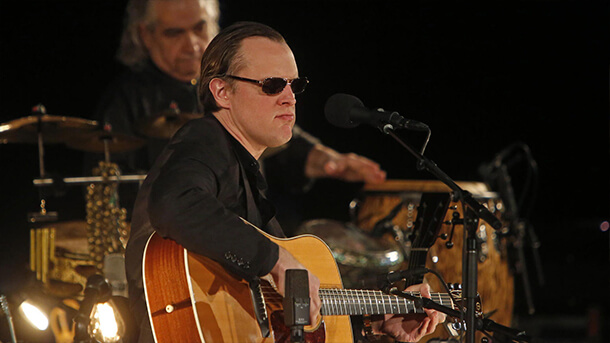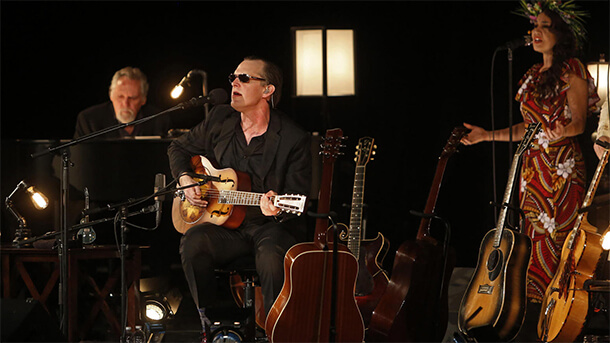



Bonamassa Acoustic Show Review: Very Different, Incredibly Enjoyable
Joe Bonamassa at Easton PA's State Theatre 1/14/2016

Photo by Brian Hineline
To be absolutely honest, when it comes to blues guitar, it’s all been done – and likely better than anyone else is going to do it.
So when the latest blues icon Joe Bonamassa came to Easton’s State Theatre with an acoustic show Thursday, it promised something different.
The surprise was just how different.
Despite his reputation for making guitars cry and scream, Bonamassa gave a 15-song, hour-and-40 minute show that focused precious little on his playing, and was mostly made up of songs from his upcoming new album (he told us in a recent interview it will be called “Blues of Desperation”).
On the fun, fast and funky “This Train” that opened the show, for example, he hardly played at all.
And yet the show still was incredibly enjoyable.
That’s because Bonamassa surrounded himself with a strong band: Pianist Reese Wynans, who is in the Rock and Roll Hall of Fame with Stevie Ray Vaughn’s Double Trouble; The Hooters’ front man and multi-instrumentalist Eric Bazilian; percussionists Hossam Ramsey of Robert Plant/Jimmy Page tour fame and Anton Fig from the David Letterman show; and Chinese cellist and erhuist Tina Guo.
On the second song, “Drive,” with Bazilian on mandolin and Guo on erhuist, Bonamassa’s playing again would have been missed were it not for a late-song flourish that drew huge applause from the nearly sold-out crowd – showing what the audience was most interested in.
Bonamassa, who stayed seated all night, dressed in a black suit with open collar and dark sunglasses, also displayed an underappreciated blues voice. It was strong and soulful on “The Valley Runs Low” and impressively belting on “Driving Towards the Daylight,” a song of nice depth and layers with Wynans’ piano and Bazilian’s banjo.

Photo by Brian Hineline
Especially with the contributions of Guo and Ramsey, the music – though based in blues and Americana – had a distinct Middle Eastern edge, as if Mumford and Sons had gone Arabic. Even later offerings such as the stomping-blues of “Blue and Evil” had that exotic feel.
“Get Back My Tomorrow,” though, was an Appalachian stomp that had the crowd clapping along, and “How Can a Poor Man” was honky-tonk blues on which Bonamassa played another solo.
The show was part of a short acoustic tour as a run-up to shows at New York’s storied Carnegie Hall on Jan. 21-22. When he finally addressed the crowd after nearly an hour of playing, he told them that when the tour was conceived, “the first thing that came to mind was ‘bring me to downtown Easton, Pennsylvania. Anything that’s good enough for Larry f—king Holmes is good enough for me.”

Photo by Brian Hineline
Of course, Bonamassa could hardly have a concert without playing some of his best songs or displaying his guitar talent, and he did that on a thumping good “Dust Bowl” and the night’s best -- a really well-played, lovely and nuanced “Mountain Time” that silenced the crowd for its six-minute length.
Those two songs drew tremendous applause, but the night had three other songs that were guitar centerpieces.
“Black Lung Heartache” had Bonamassa alone playing slide – to which his disciples in the crowd immediately began clapping along – before the full band kicked in to roaring, belting blues. There was the dramatic, 10-minute “Song of Yesterday,” which built and built, then raced to the end.
And there was “Woke Up Dreaming,” on which Bonamassa, backed only by cello, strummed so impressively fast that he got a standing ovation.
“You know, it really is much easier than it looks,” he jokingly said.
Bonamassa closed the main set with BB King’s “Humming Bird,” which allowed him to play more intentional, string-picking solos. It also got a standing ovation.
But on the encore of Bette Midler’s ”The Rose,” there was no guitar at all – just a voice and piano – until a gentle strum at the end.
It was very different for Bonamassa, but very good.










